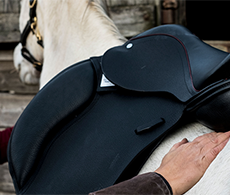
Does your horse’s saddle fit?
Independent saddle fitter Antonia Wills, who is fully qualified and registered with the Society of Master Saddlers, explains how to check.
The importance of good saddle fit
A horse who is happy, performs well and is a pleasure to ride are three ticks on any owner’s checklist. And when your horse’s saddle fits – assuming there are no other issues, of course – they will be comfortable and unrestricted, so able to perform at their best.
It’s also very important that the saddle fits you, the rider, and is suitable for all the disciplines you take part in.
‘If a saddle is too big for a rider, they’ll be unable to ride effectively,’ Antonia explains. ‘Likewise, if the saddle is too small, the rider won’t be comfortable and balanced – and being balanced is extremely important.’
Signs of poor saddle fit
It’s important that you’re able to recognise the signs that your horse’s saddle doesn’t fit – after all, you know them better than anyone else. Antonia suggests that if you experience any of the following scenarios, it could be a red flag that signals poor saddle fit:
- Your saddle slips forwards, backwards or to either side
- When observed from behind, the saddle lifts up and down following your movement in trot
- You feel tipped forwards or pushed to the back of the saddle
- You don’t feel totally centred – when you sit in the saddle, your ear, shoulder, hip and heel should naturally be in line
- Your manual therapist (physiotherapist, osteopath, sports massage professional or similar) picks up on soreness, stiffness or tension
- Your horse has a sore back – check by applying pressure where the saddle pads sit the morning after riding. If your horse reacts more than they normally would it's likely to indicate soreness
- Your horse isn’t going as well as they normally do. This change could be subtle and over time
Getting a saddle checked for fit
Saddles need to be checked for fit regularly as horses change shape throughout their lives. If their saddle doesn’t fit or sit correctly, this needs rectifying before it causes your horse to become sore. Changes in the fit of the saddle are natural and can be caused by the season, management and diet, workload or age. These factors could alter their muscle development and topline, but could also cause weight gain or weight loss – all of which will affect the fit of your horse's saddle.
‘When you buy a new saddle, it needs checking 8–10 weeks later, as in this time the new flocking will have compressed,’ Antonia explains. ‘After that, aim for six-monthly checks if you can, but at least annually. For young horses, the more regular six-month checks are particularly important because they’re changing shape at a faster rate.’
Antonia also advises getting a saddle that comes with a new horse checked.
‘When your new horse moves from their previous owner to you, their management, workload and diet are likely to change, which will alter their shape and musculature, and consequently the fit of their saddle.’
How to check saddle fit
There are a few checks you can make when assessing the fit of your horse’s saddle…
Balance
When placing the saddle on the horse’s back, the pommel and cantle should sit level and not be higher or lower than the other. There also shouldn’t be much movement in a balanced saddle either side-to-side or back to front, with no lifting at the back.
Once you’ve ridden in the saddle, check the hair underneath – the hair should be lying smooth and in the same direction. Any rubbed hair or hair pointing in a different direction could signal a badly-fitting saddle.
Clearance
There should be sufficient clearance between the pommel and the withers, ideally two to four fingers width. There should still be plenty of clearance once the saddle is girthed up and the rider is on.
There should also be sufficient clearance either side of the withers to ensure there is no pinching or rubbing, and the same applies to either side of the horse’s spine.
You should also be able to easily run your hand down the front of the saddle to ensure it isn’t too tight over the shoulders.
Bridging
This is where the saddle doesn’t sit flush along the horse’s back, and there are points of contact at the front and back but not in the middle. This can be felt by running your hand under the panels of the saddle along the horse’s back to feel for any obvious gaps. There should be a smooth, even contact.
Girths
Thanks to new research, the saddlery industry as a whole is becoming much more knowledgeable about girthing and sensitivity in the area behind the elbow. Antonia firmly believes that a girth is an important factor in saddle fit because it affects your horse’s comfort and, therefore, performance.
‘I like to fit girths that are wider as this distributes the pressure over a wider area, and I like them to be made of a soft material,’ she says. ‘Elastic girths are not ideal, especially ones that are only elastic on one side, as they are very easy to over-tighten.’
Saddle fit is quite involved, so it’s important that you find an appropriately experienced person with the right qualifications to help you with this. To find a fully qualified saddle fitter in your area, check the Society of Master Saddlers website. It takes at least three years of training to become SMS qualified, so you can be sure the members are professional, knowledgeable and keeping up to date with the latest developments.
Think your horse could do with having their saddle checked? Find a SMS saddle fitter in your area now.


